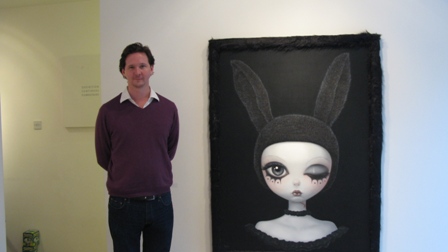| New Beijing: Young Painting from China |

|

|

|
| Features | |
| Friday, 24 September 2010 | |
|
James Freeman with Chen Hongzhu's work Contemporary Chinese art is not a talking point even in China today, but James Freeman, owner of the Sesame Gallery in London, is keen to share his fascination through his newest exhibition New Beijing: Young Painting from China.
The exhibition features ten paintings from two young Chinese artists, Chen Hongzhu and Liu Guangguang, both in their twenties. Liu’s works depict young Chinese dressed in costumes and torn between different identities, giving audience an unsettling feeling from the start. Chen’s paintings employ a brighter colour range and depict seemly perfect porcelain dolls, which are physically also suffering from the uncertainty of identity.
Freeman explained that he chose these two artists because their works are representative of paintings by China’s post-80s generation, a generation which has only started developing its unique characteristics. He said: “Unlike their predecessors, these Chinese paintings are less about politics, and more about individualism – an exploration of how Western values take root in a communist context.
“The previous generation of Chinese artists defined their vulnerability in opposition to the state; this post-80s generation looks to the expanse of ‘choice’ that the New World Order has delivered, and the sea of uncertainty that it has placed them in.”
Freeman was attracted by the uniqueness of the paintings and how subtle they depict the inner feelings of young Chinese today. Since founding Sesame seven years ago, he exhibited the works of many budding artists like Chen and Liu. Freeman planned this exhibition with help from a Beijing gallery, which he felt thankful for. He will be selling the paintings to viewers at a price between £1,100 and £4,500, and some paintings may be shipped to a similar exhibition in Geneva next month.
Liu’s work questions identity by depicting young Chinese dressed up in different costumes exploring identities. One painting showed a boy looking at himself in a puddle of water, with his reflection showing that he is wearing a gorilla costume, another showed a boy with dark framed glasses and incoherent reindeer costume pieces. Liu’s paintings also explored ways in which the Western culture is shaping young Chinese, and challenging their Chinese roots. One painting shows a girl standing in front of a traditional Chinese looking circular arch but wore a pair of typical western sneakers and held a gun.
One of Chen’s painting series depicts girls in innocent bunny costumes, with big eyes and heavy makeup. But looking closely one would find that the seemingly perfect dolls have a small cut on their white skin, with red blood creating a sharp contrast. The big size of the paintings and their simplicity made the small cuts almost unnoticeable, but more powerful consequently. Chen created a series of similar paintings each with a different coloured costume, and slight variations for the wound. “The fluffy costumes show the way that post-80s single children are being dressed up and protected carefully by their parents, but the cuts and dripping blood hint at traumas faced and survived,” Freeman gave his interpretation. He chose the silver, the black and the yellow paintings from the series for his exhibition.
Chen’s paintings exhibited many qualities of the American artist Mark Ryden, famous for adding blood and wounds to innocent and delicate images. In fact, several viewers have pointed out to Freeman that Chen’s works reminded them of Ryden. But unlike the big portions of blood that create an unsettled feeling at first glance in Ryden’s works, Chen’s depiction of damage is much more subtle.
Western art is increasingly influencing young Chinese artists like Chen and Liu. But Freeman believes that contemporary Chinese art is not influencing Western art in the same way. “Historically Chinese porcelain and decorations were seen as fashionable had a great impact on Western art. But this trend has not continued.”
But undeniably Chinese art is increasingly shown and noticed in western countries in recent years. With the help of galleries like Sesame that appreciates the value of Asian art, it may be able to contribute more to the British art landscape in the future.
Cecily Liu
|
|








